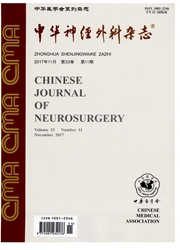

 中文摘要:
中文摘要:
目的分析和比较颅咽管瘤、囊性垂体腺瘤、Rathke囊肿及垂体脓肿等四种鞍区囊性病变的临床特征,建立鞍区囊性病变的诊断流程。方法运用统计学方法分析93例鞍区囊性病变患者的临床资料,比较不同患者临床特征的差异。结果发病年龄较小、病变体积较大、第三脑室压迫、实性部分网状强化常见于颅咽管瘤;海绵窦侵犯、实性部分均匀强化常见于囊性腺瘤;Rathke囊肿和垂体脓肿多表现为单纯囊性;病程短、尿崩、≥2个腺垂体激素低下及病变环形强化多见于垂体脓肿。结论鞍区囊性病变的临床特征互相重叠,但又有一定的特异性;综合分析,有助于这四种囊性病变的鉴别。
 英文摘要:
英文摘要:
Objective To analyze and contrast the clinical features of four kinds ofcystic lesions in sellar region such as eraniopharyngioma, cystic pituitary adenoma, Rathke cleft cyst and pituitary abscess, and to construct a flowchart for differential diagnosis of the four different kinds of cystic lesions. Methods The clinical data of 93 patients with histopathologieal evidence treated in our hospital were retrospectively reviewed. Their characteristic differences were evaluated by statistic methods. Results Young age on presentation, large volume of the lesion, compression of the third ventricleand reticularlike enhancement of the solid part were more likely to occur in craniopharyngioma. Cavernous sinus invision and homogeneous enhancement of the solid portion were more likely to occur in cystic pituitary adenoma. Rathke cleft cyst and pituitary abscess were more frequently to be seen with cystic characteristics. Short duration of preoperative symptoms, diabetes insipidus, multiple pituitary axes impaired and postcontrast enhancement of the cyst wall were more likely to occur in pituitary abscess. Conclusions The clinical characteristics and radiographic features of cystic lesions in the sellar region may mimic each other. However, part of these are specific for some diseses. A combination of the duration, ages, clinical symptoms, endocrinological and MRI features is helpful for the differential diagnosis of cystic lesions.
 同期刊论文项目
同期刊论文项目
 同项目期刊论文
同项目期刊论文
 期刊信息
期刊信息
